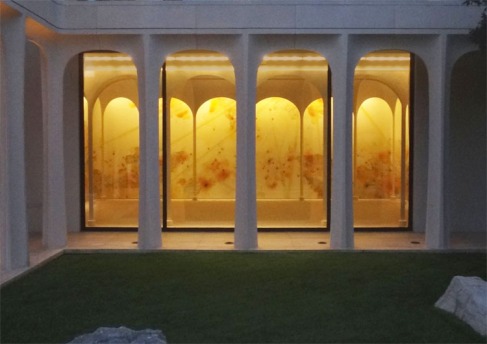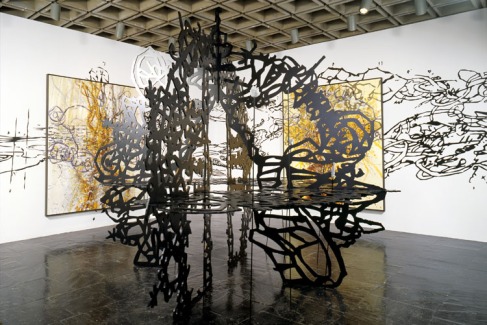A Time to Keep
Algorithmic installation, Dallas, 2011
Oil and ink on linen, sound
Music by Bryce Dessner
Algorithmic arrangement by Matthew Ritchie
Ghost Operator
Installations: White Cube Gallery, London, 2008
Navigator, Albright-Knox Museum, New York, 2011
tar, shotgun shells, acrylic tarot cards, acrylic and marker on wall, photographic prints, RFID chips
Images:
Installation views; White Cube, London, 2008
Installations: Sao Paulo Biennal, 2003
‘Remote Viewing’, Whitney Museum of Art, New York 2005
St Louis Museum of Art, 2006
Images:
‘Remote Viewing’, Whitney Museum of Art, New York
Sao Paulo Biennal, 2003
Private Collection, New York
Games of Chance and Skill
Permanent architectural installation
Massachusetts Institute of Technology, 2002
Aluminum, epoxy, etched glass, photographic prints, fluorescent lights
Images:
Installation views, Massachusetts Institute of Technology, 2002
Link:
Website commissioned for Games of Chance & Skill, 2002
Matthew Ritchie’s art revolves around a personal mythology drawn from creation myths, particle physics, thermodynamics, and games of chance, among other elements. His artistic mission has been no less ambitious than an attempt to represent the entire universe and the structures of knowledge and belief that we use to understand and visualize it. Ritchie’s encyclopedic project (continually expanding and evolving, like the universe itself) stems from his imagination, and is catalogued in a conceptual chart replete with allusions drawn from Judeo-Christian religion, occult practices, Gnostic traditions, and scientific elements and principles. Ritchie’s work deals explicitly with the idea of information being “on the surface,” and information is also the subject of his work. Although often described as a painter, Ritchie creates works on paper, prints, light-box drawings, floor-to-wall installations, freestanding sculpture, websites, and short stories, which tie his sprawling works together into a narrative structure. Drawing is central to his work. He scans his drawings into the computer so that images can be enlarged, taken apart, made smaller or three-dimensional, reshaped, transformed into digital games, or given to someone else to execute. One ongoing work that Ritchie calls “an endless drawing” contains everything he has drawn before.
Sources:
http://www.matthewritchie.com/
http://www.re-title.com/artists/Matthew-Ritchie.asp
http://en.wikipedia.org/wiki/Matthew_Ritchie
http://www.pbs.org/art21/artists/matthew-ritchie
Ch 4. Time





I really like how the artist creates these different installations. The pieces are so interactive, it makes me what to walk around them and see all the different textures and shapes from so many angles. I also think its so interesting how the artist incorporates so many themes and ideologies into his work, and his works do really look “endless.”
The one word to describe his work in my opinion is “pretty.” I just like the color scheme and the designs and the light effects he incorporated. I definitely saw structures of knowledge and the universe in his work. To me, most of his pieces look like they incorporate thought processes and science. It’s very overwhelming so I can’t see the religion aspect in his work but its interesting that he includes so much in his work. It makes it more symbolic rather than just a bunch of designs and imagination brought together.
I can’t tell what’s going on in “Ghost Operator” but the materials are strange… and interesting…